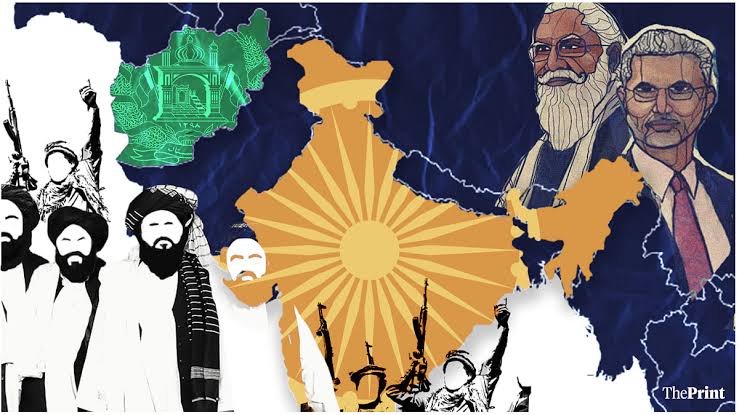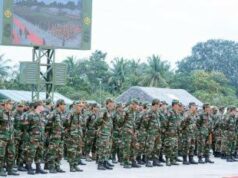Leveraging Af-Pak hostility Is it a case of lost opportunities for India?

By
Colonel Satish Singh Lalotra, Retd
‘We want an Afghanistan that is shaped by the dreams of the great Afghan people ,not by irrational fears and overreaching ambitions of others’. Narendra Modi.
The south Asian region of the Asian continent has always been in the eye of the storm with some of the most bloodiest and volatile regions forming part of this world from times immemorial. The Afghan -Pakistan region qualifies on top of this chart hands down with no rivals to give it a tough fight till date.
No wonder this region had earned the notorious moniker-‘Graveyard of empires’ which to modern day it holds true if seen in the light just two years back when the US army post haste left ‘Bagram air base’ and flew out of the war torn country in the thick of Taliban advance to the center of Afghan capital ,Kabul.
The medieval Indian history right from 9/10 th century AD is replete with examples of Afghan war lords who took to mountain passes like the Khyber, Bolan and such like to invade much prosperous Indian sub-continent with the sole aim of loot and plunder.
The war like propensities of the local populace of region straddling both sides of the ‘Durand line’ has been both a boon and bane for a much sober country like India.
It is but natural that the region can’t be oblivious to the peripherals of such a highly volatile and charged up atmosphere for too long.
The Afghans as a race are fiercely proud of their culture, religion and the quintessential ‘Jirga system’ of adherence to administering of their day to day affairs abhorring any outside interference.
It was little wonder that the British concluded the ‘Treaty of Gandamak’ in 1879 to end the first phase of Anglo-Afghan war with an Afghan victory, but gained control of lots of Afghan areas and Afghanistan ceding control of its foreign affairs to the former.
Here all lay the future seeds of conflict that resulted into the formation of the much touted ‘Durand line’ that demarcated British India from the tribal badlands of Afghanistan.
The same Durand line has been the bone of contention between the two neighbouring nation states of Afghanistan and British India/ Pakistan since the late 19th century that refuses to die down to this day and casts its shadow on present day affairs of this sub-continent.
Where does present day India figure into this entire Geo-political puzzle? Shall come to it subsequently in this write up.
Five decades of civil war, foreign intervention, and unrest in Afghanistan not only negatively impacted Pakistan but also emerged as a major destabilizing factor in central, south and west Asia.
India’s Afghan predicament and the growing hostility between Islamabad and Kabul needs to be analysed from the below explained angles.
Firstly there is a historical incongruence and asymmetric equation of sorts between these two Muslim countries.
Many readers may be surprised to no end that Afghanistan was the first nation state to cast a negative vote when Pakistan’s case for membership in the UN was presented in October 1947.
Imagine it happened at the height of so called ‘Kashmir war’ when the tribals were let loose across the newly joined state of Jammu and Kashmir by Pakistan. But it was Afghanistan that pulled the rug from the feet of a newly formed neighbour instead of its arch rival India.
The Afghan line of contention at the UN was again the much touted ‘Durand line’ as unacceptable wherein the Afghans launched many claims over the ‘Pashtun belt’ that lay across the Durand line into Pakistan.
As a corollary, readers may well remember the tall and hardy ‘Frontier Gandhi’ Khan Abdul Ghaffar Khan a bosom friend of Mahatma Gandhi who till his last breath wanted either a separate ‘Pakhtoonistan’ or a much autonomous region for Pshtoons being ethnically different from Pakistan.
Thus reinforcing Afghanistan’s line of action decades back at the UN of refusing to let Pakistan become a UN member. Did India catch on that fleeting moment of Af-Pak hostility cum opportunity to block Pakistan from the UN unless our own backyard of Kashmir was vacated from the tribal raiders?
The bilateral relations between the two countries worsened with the passage of time leading to eventual break up of diplomatic ties between Pakistan and Afghanistan in the 1960s.
Did India rise to its diplomatic endeavours and stop the Shah of Iran from doing a patch work to let the things go adrift in Af-Pak relations for its own advantage?
As if the above clues were not enough for India to get its act together, Afghanistan like a true friend remained neutral both during the 1965 and 1971 Indo-Pak wars thus proving its credibility towards India in more ways than one.
The situation was further exacerbated against Afghanistan when Pakistan joined the western alliances of ‘Baghdad pact’ (CENTO ) and South East Asian Treaty Organisation (SEATO).
A throwback to 1955 in the context of Indian sub-continent will reveal that the then USSR leader Nikita Khrushchev visited Srinagar, New Delhi and Kabul and vented his ire against Pakistan for denying the Pashtoons their legitimate demand of a separate ‘Pakhtoonistan’.
Having written so, Pakistan’s interventionist policy vis-à-vis Afghanistan since decades has metamorphosed into a groundswell of vehement opposition to the antics of the former.
Though in the initial years of Soviet intervention cum occupation did make the Afghans gravitate towards Pakistan for any militaristic cum humanitarian aid it made the Afghans harden their anti-Pakistan feelings in Kabul when it was evident to them that Pakistan under the garb of helping them was stoking regional aspirations for themselves. Was India able to cash on this opposition surge in almost the whole of Afghanistan?
The fact that Pakistan based Taliban functioning in close cohorts with the ‘Afghan Bureau’ of ISI were the main proponents in getting the Afghan ex-president Najibullah killed brutally along with his brother In 1996 ,India didn’t cash on the Pashtoon sentiments so generated by this gruesome act to take on Pakistan in a more confrontationist manner.
Moreover Afghanistan is a 200 year old nation state as compared to the theological state of Pakistan integrating various tribes/Jirgasas done by its ruler Ahmed shah Abdali in 1747. For the second time in its history Afghanistan has been imposed with a Pro-Pakistan Taliban rule rather than a regime with active support of India.
Over the last 2 decades Indian public and private sector entities had invested around $ 3 billion in the infra sector of this war torn neighbour.
With Taliban control over Afghanistan in August 2021, most of these Indian companies were left in the lurch only to be called back now laced with lots of trepidation on the part of these Indian entities.
The aggravating relations between both Afghanistan & Pakistan in the wake of accusations and counter accusations from both sides and back to back terrorist attacks from Afghanistan reveal serious hostility and trust deficit between the 2 countries.
Closing and opening of Torkham border crossing and warning by Pakistan that under no circumstances will it allow Afghanistan to construct structures on its territory means a serious rupture of relations between the two countries.
With the Taliban regime accusing Pakistan of opening fire on Afghan security forces and creating problems at Karachi port, violating the trade and transit agreement things of purported importance seem to hurtle down the abyss of open hostility.
As if the above unfolding of events were not enough, the meteoric rise of TTP/Tehrik -e- Taliban Pakistan in the northern frontiers particularly the Swat and Hunza valley of Pakistan portends dangerous consequences for both the countries which India should make best use of by cultivating the mavericks of TTP for its own ends in Jammu and Kashmir.
Time has come for India to turn the tables against Pakistan by reverse-modeling it’s so called ‘Strategic depth ‘formula in Afghanistan by leveraging this raging Af-Pak hostility and making the most of this God send opportunity thereby easing the pressure in Jammu and Kashmir from the nagging problem of state – sponsored terrorism from across the border.
(The writer is a retired army officer)



